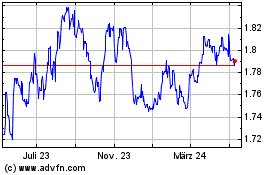Antipodean Currencies Rise Amid Risk Appetite
29 August 2023 - 4:24AM
RTTF2
The Australian dollar strengthened against other major
currencies in the Asian session on Tuesday amid risk appetite, as
investors welcomed China's announcement of a slew of measures over
the weekend to bolster the country's equity market as well as fuel
an increase in spending and drive economic growth. The resultant
firming of commodity prices also aided sentiment.
China put forth stimulus to ease market unrest and drive
economic growth. It reduced stamp duty on stock trades by 50
percent and will slow down the pace of initial public offerings.
China's securities regulator also approved the launch of 37 retail
funds.
Traders also look ahead to an upcoming speech by incoming
Reserve Bank of Australia governor Michele Bullock later in the day
for clues on the outlook for domestic interest rates and the
broader economy.
In the Asian trading today, the Australian dollar rose to more
than a 1-month high of 1.0889 against the NZ dollar and a 2-week
high of 94.47 against the yen, from yesterday's closing quotes of
1.0874 and 94.21, respectively. If the aussie extends its uptrend,
it is likely to find resistance around 1.09 against the kiwi and
96.00 against the yen.
Against the U.S. and the Canadian dollars, the aussie advanced
to 5-day highs of 0.6454 and 0.8769 from yesterday's closing quotes
of 0.6429 and 0.8742, respectively. The aussie may test resistance
around 0.68 against the greenback and 0.90 against the loonie.
The aussie edged up to 1.6792 against the euro, from yesterday's
closing value of 1.6823. On the upside, 1.63 is seen as the next
resistance level for the aussie.
The NZ dollar rose to 0.5929 against the U.S. dollar and 86.79
against the yen, from yesterday's closing quotes of 0.5909 and
86.61, respectively. If the kiwi extends its uptrend, it is likely
to find resistance around 0.62 against the greenback and 88.00
against the yen.
Against the euro, the kiwi edged up to 1.8277 from Monday's
closing value of 1.8297. On the upside, 1.79 is seen as the next
resistance level for the kiwi.
Meanwhile, the safe-haven currencies such as the U.S. dollar and
the Japanese yen weakened against its major counterparts amid risk
appetite.
The U.S. dollar fell to 4-day lows of 1.0839 against the euro
and 1.2633 against the pound, from yesterday's closing quotes of
1.0817 and 1.2603, respectively. If the greenback extends its
downtrend, it is likely to find support around 1.11 against the
euro and 1.28 against the pound.
Against the yen and the Swiss franc, the greenback edged down to
146.31 and 0.8826 from yesterday's closing quotes of 146.54 and
0.8836, respectively. The greenback is likely to find support
around 143.00 against the yen and 0.86 against the franc.
The greenback slipped to 1.3587 against the Canadian dollar,
from Monday's closing value of 1.3597. On the downside, 1.33 is
seen as the next support level for the greenback.
In economic news, data from the Ministry of Internal Affairs and
Communications showed that the unemployment rate in Japan came in
at a seasonally adjusted 2.7 percent in July. That exceeded
expectations for 2.5 percent, which would have been unchanged from
the June reading.
The yen fell to a 1-week low of 158.66 against the euro and a
6-day low of 184.99 against the pound, from yesterday's closing
quotes of 158.51 and 184.68, respectively. If the yen extends its
downtrend, it is likely to find support around 160.00 against the
euro and 188.00 against the pound.
Against the Swiss franc, the yen dropped to 165.88 from Monday's
closing value of 165.77. The yen may test support around the 168.00
region.
Looking ahead, U.S. S&P/Case Shiller house price index for
June and U.S. CB consumer confidence for August are due to be
released in the New York session.
Euro vs NZD (FX:EURNZD)
Forex Chart
Von Jun 2024 bis Jul 2024

Euro vs NZD (FX:EURNZD)
Forex Chart
Von Jul 2023 bis Jul 2024
